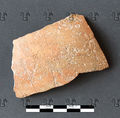EN-1 potsherd
| Object | |
|---|---|
| Classification: | vessel |
| Material: | pottery |
| Size: | length 7.3 cm, height 4.6 cm+ |
| Condition: | fragmentary |
| Date: | 5th–1st centuries BC |
| Date derived from: | archaeological context |
|
| |
| Site: | Ardez (fraction of: Scuol, Graubünden, Switzerland) |
| Field name: | Suochastè |
| Coordinates (approx.): | 46° 46' 30.00" N, 10° 12' 7.20" E [from site] |
| Find date: | 11.8.1969 |
| Find circumstances: | excavation in cause of construction works |
| Current location: | Rätisches Museum Chur (on exhibition) |
| Inventory Nr.: | P 1973/2842 |
|
| |
| Inscription: | EN-1 (aχ?[) |
|
| |
| Sources: | Risch 1984: 29–30, fig. 9 Risch 1989: 1580 (No. 1), fig. 7 |
Images
|
Object EN-1 potsherd with inscription EN-1.
|
Object EN-1 potsherd with inscription EN-1.
|
Commentary
Ceramic fragment.
Medium-fine, hard-fired clay with a moderate temper of fine grained sand and cast gold as well as fine grained lime. Mixed fire; outside oxidation firing, light red brown in colour; inside principally reduced firing, from light red brown to black in colour. Outside probably burnished.
The potsherd from Ardez is very distinguished because of the alphabetic characters the fragment bears. From there this is the most occidental evidence known so far.
Found 1969 in Suochastè near Ardez, however inventoried only in December 1973; in addition to the potsherd some antlers and bones with characters (see Risch 1984: 29, fig. 10a, fig. 10b, fig. 11, or Risch 1989: 1580, fig. 8, fig. 9, fig 10) were found, at which the interpretation of these characters are uncertain (Risch 1989: 1580).
According to the excavations executed in Suochastè the location was populated from the late Bronze Age (Laugen-Melaun culture from the 13th to the 6th centuries BC) to the late Iron Age (Fritzens-Sanzeno culture from 5th to 1st centuries BC). The potsherd dates to the Fritzens-Sanzeno culture due to the alphabetic characters.
As yet the results as well as the discoveries of the excavation are not published (To control this information made by Risch).
Bibliography
| Caduff 2007 | Bruno Caduff, "Ardez-Suotchastè. Eine urgeschichtliche Fundstelle im Unterengadin (GR)", Jahrbuch der Historischen Gesellschaft von Graubünden (= 137. Jahresbericht der Historischen Gesellschaft) (2007), 5–98. |
|---|

